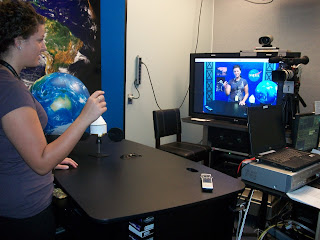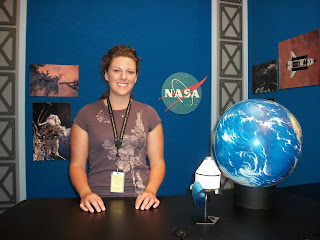For my second internship at Johnson Space Center I was trained as a Test Director, and asked to develop a process to remove the weld washer from the NASA Standard Initiator (NSI). The NSI is the 'match' of an explosive system. With thousands of flight ready NSIs left over from the Shuttle Program, the weld washer's needed to be removed to utilize the NSI in the Multi-Purpose Crew Vehicle (MPCV) that NASA is working on now. By performing this process in house, NASA saves time and money. You can see the weld washer in the picture below which is used to attach the NSI to a larger explosive component, such as the NASA Standard Detonator.
Common Configuration of the NASA Standard Initiator
To begin, I familiarized myself with the machine shop and learned to use the lathe.
The process took off from there.
I developed two pieces of hardware for the process, including an NSI Output Redirector. This piece of hardware was designed for my protection. In the case of inadvertent ignition of the NSI, the Output Redirector directs the explosion away from me. During the first test of the NSI Output Redirector, everything went extremely well. I definitely feel safe being on the other side of that flimsy blast shield now!
Test of the NSI Output Redirector
After proving that I could successfully and safely remove the weld washer, writing the Operating Checklist, Hazard Analysis, and Test Plan, the process began.
I successfully removed 64 weld washers while staying withing tolerances on each one. I wrapped up this project in the fourth week of my eight week internship and moved on to another exciting project.
When I first arrived at the Pyrotechnics laboratory, I had the opportunity to go in the bunkers where all the explosives are stored. We discovered that there were many old explosives that were being stored from early Gemini and Apollo programs, waiting to be disposed of. This became the focus of my second project.
I chose the Ejection Seat Pyrotechnic Systems (of which we had two), and developed a test plan for disposing of them safely.
Each Ejection Seat Pyro System included two gas generators, a hot gas initiator, and shielded mild detonating cord (SMDC), all mounted on a aluminum plate. These ejection seat pyros were intended to be used in the Shuttle to eject the pilots, but when three additional seats were added to the shuttle flight deck before its maiden flight, they ousted the ejection seat idea.
I decided to disassemble each system and put the individual parts into an Auto Ignition chamber at 1500 degrees to assure that all explosives are burned off. The test was a success and the after affects are shown below.
After the Auto Ignition Chamber
Left: Aluminum Ingot from the Plate
Right: Gas Generator
As a little extra project, I made a display for the Pyrotechnics lab to use to display a vast array of Pyros commonly used at NASA. Here are a few of the pictures of my display for everyone to get a glimpse of what NASA commonly uses pyrotechnics for.
The NSI is used to detonate every one of these explosives.
The 3 1/2 inch frangible nut on the right was used to hold the
Shuttle to the External Tanks during take-off.
I'm planning to return to either SpaceX, NASA or Blue Origin this coming Fall for a Co-op and hoping for another opportunity to work in a test facility.








